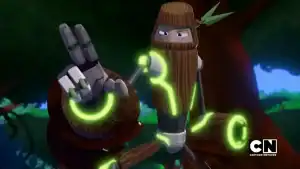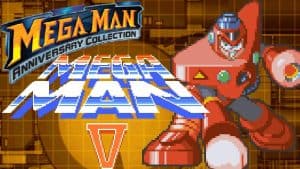
One of my all-time favorite video game IPs is the mainline “classic” series of the Mega Man meta-franchise that began in 1987 with the very first game released for the NES. It subsequently established the formula of its sequels’ usage of a “rock-paper-scissors” method of defeating bosses with assigned elemental weaknesses. To keep this list as brief and focused as possible, let’s take a cursory look at each of the ten main games’ best “Robot Master” bosses.
10. Cut Man (Mega Man, 1987)
As one of the Mega Man series’ most iconic and recognizable Robot Masters (with an equally popular stage theme), Cut Man is a fairly average-looking but deceptively fast and furious enemy who wields the scissor-like “Rolling Cutter” weapon sitting on the top of his head with deadly efficiency. Cut Man has made various cameos throughout the game series (in particular, hidden boss fights in the Sega Saturn version of Mega Man 8 and all versions of Mega Man X8) and even prominent appearances in ancillary media (such as being featured in every episode of the 1994 Mega Man animated series).
9. Wood Man (Mega Man 2, 1989)

Having as nearly of a ubiquitous presence as Cut Man before him, Wood Man from Mega Man 2 is an admittedly strange-looking robot resembling a tree stump, as supplemented by the appearance of his signature “Leaf Shield” weapon (consisting of four razor-sharp and damage-resistant “leaves” that orbit around in a circular pattern). Again, like with Cut Man, Wood Man has made many cameos across various future games (including an appearance as another hidden boss in MM8‘s Saturn port) and minor but noteworthy roles in one-off episodes of Captain N and the 1994 animated series.
8. Gemini Man (Mega Man 3, 1990)
Despite Mega Man 3‘s ostensibly rushed (and reportedly incomplete) development, it’s still probably my favorite entry due to it being the very first game I played in the overarching series (though I did seek out and play the first two afterwards). Another reason I really like MM3 was its early attempts at experimenting with new boss gimmicks not seen in its predecessors: in this case, the utilization of Gemini Man‘s ability to split into two separate bodies while firing his ricocheting “Gemini Laser” weapon – both making for a frantic fight requiring considerable patience and timing.
7. Pharaoh Man (Mega Man 4, 1991)
I’m admittedly a sucker for ancient Egyptian culture and iconography, so having a Robot Master directly modeled after a pharaoh (with an appropriately desert and catacomb-themed stage) was a surefire choice for inclusion on this list. Mega Man 4‘s regal-looking Pharaoh Man, wielding the special “Pharaoh Shot” weapon allowing him to gather and launch spheres of solar energy, grabbed my attention as soon as I saw him featured semi-prominently on the game’s North American box art.
6. Gravity Man (Mega Man 5, 1992)

Much like Gemini Man mentioned above, Gravity Man from 1992’s Mega Man 5 also featured a unique gimmick in both the actual boss fight and preceding stage: namely, the disorienting element of having the in-universe gravity (and players’ control input) reversed. This not only makes traversing Gravity Man’s stage a bit harder due to the game’s interface (literally) being turned on its head but also pushes for better precision and timing to avoid and shoot at the boss himself.
5. Yamato Man (Mega Man 6, 1994)
And much like Pharaoh Man mentioned above, Yamato Man from 1994’s Mega Man 6 scratches my similar itch for feudal Japanese culture and iconography: in this case, having a Robot Master based on a samurai warrior with a stage themed after an ancient Japanese fortress. Wielding the “Yamato Spear” weapon both offensively and defensively, Yamato Man’s fighting technique is appropriately measured and deliberate (but leaves himself open when physically retrieving his primary spearhead).
4. Shade Man (Mega Man 7, 1995)
As an adamant lover of horror-themed media in general, and the various iterations of Bram Stoker’s Dracula in particular, the Robot Master Shade Man from 1995’s Mega Man 7 is a personal favorite since his stage is essentially a “haunted” castle and he’s basically a robotic “vampire.” Taking on an appropriately bat-like appearance, Shade Man flies around on wings and can even bite and “drain” players of their energy; likewise, in a mimicry of a bat’s echolocation, Shade Man utilizes the special “Noise Crush” attack where he fires a soundwave that can bounce off of surfaces to amplify in power.
3. Tengu Man (Mega Man 8, 1997)
Conceptually based on the crow-like demons from Japanese mythology, Tengu Man is a Robot Master with a very sleek and bird-like design that greatly emphasizes his flight capabilities, intense speed, and ability to generate whirlwinds that can slash through solid objects. Of note is his retractable “Tengu Blade” weapon that he can launch out and use to trap players within his “Tornado Hold” attack; also noteworthy is Tengu Man’s reappearance with fellow MM8 boss Astro Man alongside six new Robot Masters in the 1998 spinoff Rockman & Forte (a.k.a. Mega Man & Bass).
2. Splash Woman (Mega Man 9, 2008)

Following a 10-year gap of new games in Mega Man‘s “classic” series since the release of Rockman & Forte/Mega Man & Bass in 1998, Mega Man 9 was officially debuted as a brand-new mainline sequel that went back to the 8-bit visual aesthetics of the earlier NES entries. Not only did the game feature an entirely new roster of bosses, but it also introduced something never seen before in the classic series: the female Robot Master Splash Woman; designed to resemble a mermaid, Splash Woman wields the “Laser Trident” weapon and can even call on swarms of fish-like robots to attack.
1. Blade Man (Mega Man 10)
Developed as a similarly retro-styled follow-up to MM9, 2010’s Mega Man 10 introduced eight additional new Robot Masters needing to be challenged and defeated (including the hilariously bizarre Sheep Man). However, the most strikingly (and sharply) designed of the eight bosses is Blade Man: having a notably lean and obviously sword-like appearance, this Robot Master attacks players with his “Triple Blade” technique that utilizes the blade-like attachments on his head and both arms.
More must-reads:
- Insider shares major LeBron James retirement update
- Steelers, T.J. Watt finalize extension to make him highest paid non-QB again
- The 'MLB All-Star Game MVPs' quiz
Breaking News
Trending News
Customize Your Newsletter
 +
+
Get the latest news and rumors, customized to your favorite sports and teams. Emailed daily. Always free!








